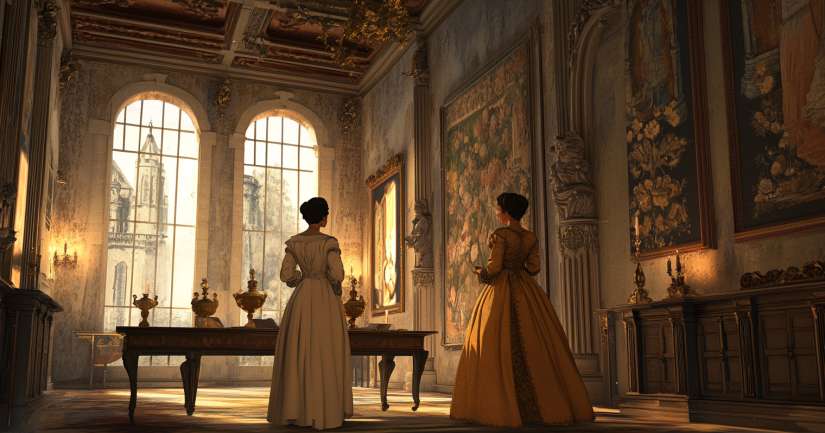
Katherine struggles with English lessons in Henry V Act 3 Scene 4 Quiz—how well do you recall this lighthearted scene? Henry V Act 3 Scene 4 Quiz fans, get ready to explore a lighthearted yet culturally revealing moment in Shakespeare’s historical play. This scene shifts from the intensity of war to a comic interlude in the French court, where Princess Katherine of France receives an amusing and somewhat clumsy English lesson from her lady-in-waiting, Alice. Shakespeare uses this scene to humanize the French perspective, introduce humor, and foreshadow Katherine’s role in the play’s resolution.
The scene takes place in the French court, where Princess Katherine practices English with her maid, Alice. Knowing that Henry V is advancing toward victory, Katherine begins learning the English language, hinting at the possibility of a future political marriage between her and the English king.
The French court is in turmoil—how well do you remember this scene? Continue the drama with Henry V Act 3 Scene 5 Quiz as the French strategize. Want to go back to Henry’s battlefield victories? Test yourself with Henry V Act 3 Scene 3 Quiz. And if you want a broader challenge, take on the Henry V Shakespeare Quiz!
Enter the Henry V Act 3 Scene 4 Quiz Now
Henry V Shakespeare Quizzes: Think you know Shakespeare’s legendary king?
Summary of Henry V Act 3 Scene 4
Alice, having spent time in England, attempts to teach basic English words for body parts, including hand, fingers, nails, arm, elbow, and foot. However, Katherine struggles with pronunciation and unknowingly misinterprets some words as inappropriate, leading to moments of innocent comedy.
Though seemingly a comic relief scene, Katherine’s language lesson carries deeper meaning. Her learning English symbolizes France’s eventual submission to England and foreshadows her marriage to Henry as part of the peace negotiations.
Key Themes in Henry V Act 3 Scene 4
Shakespeare explores language, cultural differences, and the role of women in political alliances. Katherine’s lesson in English highlights the contrast between the French and English and serves as a metaphor for the gradual shift of power toward Henry.
Another major theme is marriage as diplomacy. Katherine, though playful in this scene, is ultimately a political pawn, and her future is already being shaped by the outcome of war. This scene humanizes her character, making her later interactions with Henry more engaging and sympathetic.
Shakespeare’s Use of Language and Humor
This scene is one of the few instances in Shakespeare where French dialogue is used extensively, emphasizing the divide between the two cultures. Katherine’s mispronunciations and innocent misunderstandings create gentle comedy, lightening the tone of the play amidst war.
Alice’s role as a teacher provides an authentic, if slightly flawed, English lesson, while Katherine’s frustration and amusement add to the scene’s charm and realism. Shakespeare skillfully blends linguistic playfulness with deeper political subtext, making the scene both entertaining and meaningful.
The Historical Context of Act 3 Scene 4
Katherine of Valois was a real historical figure who later became Henry V’s queen after the Treaty of Troyes. Her marriage to Henry was meant to unite England and France, though Shakespeare dramatizes her role for comedic effect. In reality, Katherine was likely more politically aware than this scene suggests, but Shakespeare’s portrayal helps make her a relatable and charming character.
Are You Ready for the Henry V Act 3 Scene 4 Quiz?
Think you understand how Shakespeare uses humor, the significance of Katherine’s language lesson, and the deeper political symbolism behind the scene? Do you remember which English words Katherine learns and how she reacts to them?
This Henry V Act 3 Scene 4 Quiz will test your knowledge of Shakespeare’s comic genius, cultural contrasts, and the foreshadowing of political marriage. Take the quiz now and see if you can decode the humor, language, and meaning behind this lighthearted scene
What Happened – Henry V Act 3 Scene 4
In Act 3, Scene 4 of Henry V, the scene takes place in a room in the French palace. Princess Katherine of France is present. She is with her lady-in-waiting, Alice. Katherine wants to learn English. She asks Alice to help her. Alice knows a little English and agrees to teach her.
Katherine starts by asking about different parts of the body. She wants to know the English words for them. Alice tells her the English words for “hand,” “fingers,” “nails,” “arm,” “elbow,” “neck,” “chin,” “foot,” and “gown.” Katherine tries to repeat the words after Alice. Some words sound funny to her. She laughs at how they sound. Katherine struggles with the pronunciation. She finds it difficult to say the words correctly. Despite this, she continues to practice.
Katherine is determined to learn. She repeats the words several times. Alice encourages her and corrects her mistakes. Katherine is eager to know more English words. She is curious and keen to improve her language skills. The scene ends with Katherine still practicing. She is focused on learning and seems to enjoy the process. The interaction between Katherine and Alice is friendly and supportive.
Henry V Act 3 Scene 4 – Quotes
- “Je pense que vous êtes le gentilhomme de bonne qualité.”. Katherine, ‘Katherine is practicing her English with her gentlewoman, Alice, as they discuss language and social status.’
- “Les mains sont pour laver.”. Alice, ‘Alice corrects Katherine’s pronunciation while they continue their language lesson, showcasing the cultural exchanges between the French and English.’
- “De fingres?” – Katherine, ‘Katherine struggles with the English word for “fingers,” illustrating the comedic challenges of learning a new language.’
- “Oui, je peux dire les mains.”. Katherine, ‘Katherine gains confidence in her English skills, signifying her determination to learn and adapt amid the backdrop of war and politics.’
